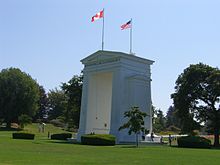49th parallel north
The 49th parallel north is a circle of latitude that is 49° north of Earth's equator. It crosses Europe, Asia, the Pacific Ocean, North America, and the Atlantic Ocean.
The city of Paris is about 15 km (9 mi) south of the 49th parallel and is the largest city between the 48th and 49th parallels. Its main airport, Charles de Gaulle Airport, lies on the parallel.
Roughly 2,030 kilometres (1,260 mi)
From a point on the ground at this latitude, the
Around the world

Starting at the
Monuments on the parallel

- In North America, the westernmost monument on the 49th parallel is the Point Roberts Boundary Monument near the corner of Marine Drive and Roosevelt Way in the Point Roberts, Washington exclave south of Delta, British Columbia.
- The Peace Arch is a large monument between Surrey, British Columbia, and Blaine, Washington. It is the centerpiece of Peace Arch Park.
- Waterton-Glacier International Peace Park in Alberta and Montana
- The International Peace Garden is located at the border between Manitoba and North Dakota, about midway between the nearby communities of Boissevain, Manitoba and Dunseith, North Dakota. Until its demolition in 2017, the Peace Tower stood at the focal point of the garden, on the border. As of 2018, a new tower is slated to be constructed on the spot.[3]
- The Stadtgarten in Karlsruhe, Germany, marks the 49th parallel with a stone and painted line.
- Monument in the northern part of town centre, Prešov, Slovakia.
-
49th parallel north in Karlsruhe
-
49th parallel north in Karlsruhe
-
Monument marking the 49th parallel in Prešov
Canada–United States border

History
In 1714, the Hudson's Bay Company proposed the 49th parallel as the western portion of the boundary between the company's land and French territory. At the time, Britain and France had agreed, in the Peace of Utrecht, to negotiate a boundary, but negotiations ultimately failed.[4]
Following the
Although the Convention of 1818 settled the boundary, neither country was immediately able to control over the territories on its side of the line; effective control still rested with local First Nations peoples, mainly the
In the
As border

Although parts of Vancouver Island and parts of Eastern Canada are south of the 49th parallel, and parts of the United States (
Parts of the 49th parallel were originally surveyed using astronomical techniques that did not take into account slight departures of the Earth's shape from a simple
The Northwest Angle is the only part of the contiguous 48 states that goes north of the 49th parallel. The Treaty of Paris called for the boundary between the US and British territory to pass through the most northwesterly point of Lake of the Woods, and this was retained even after an 1818 treaty set the boundary west of that point to follow the 49th parallel.
At the time that the United States and Great Britain agreed on the 49th parallel as the boundary, much of the North American continent had not yet been mapped. After the boundary was established, British surveyors discovered that Point Roberts lay south of the 49th parallel. The British requested that the United States cede the territory to Great Britain, but no action was ever taken.
In 1909 the United States, United Kingdom, and Canada signed and ratified a treaty confirming the original survey lines as the official and permanent international border. Nevertheless, in 2002 the difference of the survey from the geographical 49th parallel was argued in front of the Washington Supreme Court in the case of State of Washington v. Norman,[6] under the premise that Washington did not properly incorporate the portions of land north of the geographical 49th parallel, as laid out by detailed GPS surveying. The court decided against the premise, ruling that the internationally surveyed boundary also served as the state boundary, regardless of its actual position.
Ordnance Survey of Great Britain
The
See also
- 48th parallel north
- 49th Parallel, 1941 Canadian and British film
- Hymns of the 49th Parallel, 2004 album by k.d. lang
- 50th parallel north
- Boundary Lake (Manitoba/North Dakota)
- Northwest Angle (northern Lake of the Woods County)
- Oregon boundary dispute
- Pig War, 1859
- War of 1812
- Weißwurstäquator
References
- ^ Jacobs, Frank (28 November 2011), "The Not-So-Straight Story of the U.S.-Canadian Border", New York Times, retrieved 13 May 2020
- ^ "Duration of Daylight/Darkness Table for One Year". U.S. Naval Observatory. 24 September 2019. Archived from the original on 12 October 2019. Retrieved 10 March 2021.
- ^ Dobbie, Dorothy (18 March 2018). "International Peace Garden to Celebrate Its 85th Birthday". Retrieved 14 May 2019.
- ISBN 978-0-87351-153-7.
- ^ O'Brien, Sharon (1984). "The medicine line: A border dividing tribal sovereignty, economies and families". Fordham Law Review. 53 (2): 315–350. Retrieved 9 July 2019.
- ^ State v. Norman 145 Wn.2d 578 (2002)
- ^ "The true origin". Welcome to OS Net. Southampton: Ordnance Survey. 4 September 2007. Archived from the original on 5 December 2008. Retrieved 13 August 2009.





